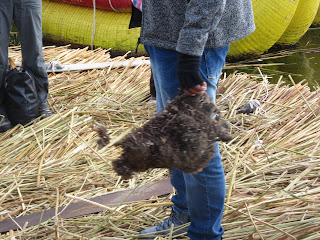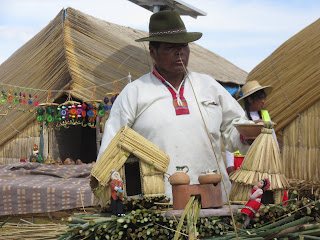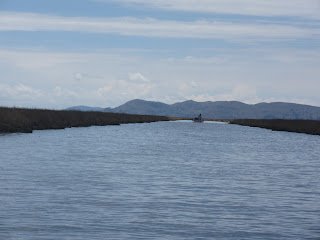One of the reasons we had come to the city of Puno in the southern Andes was to visit Lake Titicaca, a rival in magnificence to Machu Picchu, and home to the floating Uros islands. The lake, larger than Puerto Rico, is the world's largest navigable lake at 12,5000 feet above sea level. The lake's surface covers 3,340 square miles between Peru and Bolivia with 57% in Peru.
Steven was still feeling the effects of the region's high altitude so he once again thought it best to rest in the hotel rather than join me on the pre-arranged tour as it involved an arduous walk. After I was picked up at 7, I had a mini tour of Puno with other tour participants being picked up at ten different hotels!
While waiting for the boat to leave, we had musical accompaniment, the first I'd experienced. In case you're not familiar with the instrument the musician had in his mouth, it's a pan pipe. We had first heard its beautiful lilting music live in the Salineras de Maras, the salt mines in Peru's Sacred Valley.
Most of Lake Titicaca, which means 'lake of the gray' (titi) 'puma' (caca) in Quechua, is part of the Titicaca National Reserve dedicated to conserving the region's plants and animal life while promoting sustainable use of its resources.
The lake is the most important one in the Andean world because of the ancient ethnic groups like the Uros, Lupaca, Colla, Aymara and Quechua who settled there but also for its meaning as the birth of Andean civilization. Once we were under way by 7:30, our guide, Manuel, mentioned there are three official languages in Peru: Spanish, Aymara and Quechua. Aymara was mostly spoken in the agricultural city of Puno while the latter was spoken in Cusco and the Sacred Valley.
Most islanders now earn a living from tourism, hunting, collecting birds' eggs and fishing 36 varieties of fish in the lake. The most important fish, Manuel said, was trout first introduced by Canada to the lake in 1914. Go Canada!
There were about two thousand inhabitants in the floating islands. The largest one, estimated to be 160 years old, included a meeting house and a primary school. Replenished often with layers because the underbelly reeds rot, these tiny islands resembled floating bales of hay and averaged ten feet thick. The islands last thirty to thirty-five years before sinking; then they must build another floating island.
The islanders used to have sticks to cut the totora reeds but now use 'modern technology': i.e. a saw! Marcus, just visible in the background, measured the depth of the island for us and calculated it was 7 meters or about 23 feet deep. It sure wasn't going anywhere quickly!
I, like most of the tour participants, opted to eat a portion of the reed. I recall it as being pretty flavorless.
Marcus said up to 40 people could go, for an additional cost, for a 'romantic boat ride' on the islanders' Venice boat and 14 people could fit in the smaller canoe-type boat. I chose the smaller one as my love was back in Puno recovering from the high altitude.
There was quite a breeze on the lake so the man must have had to struggle rowing the boat.
The Venice boat, aka the gondola!
Marcus explained that the roots in the large bale were still alive. The islanders harvest reeds from five kilometers away and place them on top of the roots which must be anchored.
Marcus demonstrated that more reeds must be added monthly.
That meant their homes had to be lifted up each time as Marcus pantomimed!
A sample of jerky was passed around the group. There is no refrigeration on the floating islands.
Marcus informed us that on Saturdays, islanders go in their small boats to the market in Puno to buy rice, etc with money earned from handicrafts, etc sold to tourists during the week. He added that because it's so cold at night on the lake, many islanders have problems with rheumatism and arthritis.
The residents introduced themselves to us.
This couple had no children but 'were practicing!'
How adorable was this small boy as we landed on the larger island!
Steven was still feeling the effects of the region's high altitude so he once again thought it best to rest in the hotel rather than join me on the pre-arranged tour as it involved an arduous walk. After I was picked up at 7, I had a mini tour of Puno with other tour participants being picked up at ten different hotels!
Once at Puno's port, we had to walk across from one boat to another until we reached ours.
Most of Lake Titicaca, which means 'lake of the gray' (titi) 'puma' (caca) in Quechua, is part of the Titicaca National Reserve dedicated to conserving the region's plants and animal life while promoting sustainable use of its resources.
The lake is the most important one in the Andean world because of the ancient ethnic groups like the Uros, Lupaca, Colla, Aymara and Quechua who settled there but also for its meaning as the birth of Andean civilization. Once we were under way by 7:30, our guide, Manuel, mentioned there are three official languages in Peru: Spanish, Aymara and Quechua. Aymara was mostly spoken in the agricultural city of Puno while the latter was spoken in Cusco and the Sacred Valley.
As the boat motored toward the 87 man-made floating Uros Islands in the shallow part of the lake, Manuel pointed out the tortora reeds, a reed-like papyrus, along the lake's shores. They were valuable as cattle fodder for farmers around Puno, firewood, handicrafts, building materials for homes and boats, and, in times of famine, food for humans. The reeds also contain essential calcium and iodine.
The ranger station in the canal nearing the lake was our first sight of a man-made island made of tortora reeds.
The Uros developed their unique floating islands centuries ago to escape hostile cultures on the mainland and escape from attacks from stronger, more aggressive neighbors. Today, they stay in one place. They consider themselves to be 'the oldest people on earth.' Legend says they existed before the sun and could not drown or be struck by lighting. Mixing with the Aymaras and other tribes lost their super-being status. When the Spanish chroniclers encountered the Uros people by the end of the 16th century, the people were still living on the lake in small reed-boats that they used as floating houses. Only in the early 1960s did the Uros started to build small artificial islands with reeds for their homes.Most islanders now earn a living from tourism, hunting, collecting birds' eggs and fishing 36 varieties of fish in the lake. The most important fish, Manuel said, was trout first introduced by Canada to the lake in 1914. Go Canada!
There were about two thousand inhabitants in the floating islands. The largest one, estimated to be 160 years old, included a meeting house and a primary school. Replenished often with layers because the underbelly reeds rot, these tiny islands resembled floating bales of hay and averaged ten feet thick. The islands last thirty to thirty-five years before sinking; then they must build another floating island.
Our guide said the last person who spoke the Uros language died in 1911 at the age of 87. Manuel taught us a couple of important Aymara phrases: 'Camiserati' which meant 'Good morning and how are you?' If we didn't say that and the response of 'Waliki' for 'I am fine,' the Uros people we'd soon be meeting might throw us in the lake!
Before we disembarked on one island just thirty minutes from Puno, I was surprised to learn islanders had tvs, solar panels and satellite dishes. The people drink lake water after boiling it. If they get sick, they go to the hospital in Puno.
Stepping off the boat onto the reed island was a bit like being on a boat during choppy waters. It was an odd sensation as I could feel my feet sink several inches into the spongy reeds. I just hoped this island wasn't nearing the thirty year plus mark!
Every island had its own rotating president; this was Marcus, 'our' island's current president. He said seven families and twenty-two people lived on the island.
The roots, like the one below, float naturally and are the foundation of the islands. Marcus encouraged us all to jump and down on the reeds but it didn't sink as it was only twenty years old, he said!The islanders used to have sticks to cut the totora reeds but now use 'modern technology': i.e. a saw! Marcus, just visible in the background, measured the depth of the island for us and calculated it was 7 meters or about 23 feet deep. It sure wasn't going anywhere quickly!
I, like most of the tour participants, opted to eat a portion of the reed. I recall it as being pretty flavorless.
Some of the islanders:
Marcus said up to 40 people could go, for an additional cost, for a 'romantic boat ride' on the islanders' Venice boat and 14 people could fit in the smaller canoe-type boat. I chose the smaller one as my love was back in Puno recovering from the high altitude.
There was quite a breeze on the lake so the man must have had to struggle rowing the boat.
The Venice boat, aka the gondola!
Our boat ride was supposed to have lasted 40 minutes but we had to be content with just a 15 minute ride to the center of this small area of the lake before returning to 'land' where one of the islanders awaited us.
This was the reed boat I had been in; I don't think I've ever been so close to the water in a boat before!
We all gathered round in a circle so Marcus could further tell us about life on the island.Marcus explained that the roots in the large bale were still alive. The islanders harvest reeds from five kilometers away and place them on top of the roots which must be anchored.
Marcus demonstrated that more reeds must be added monthly.
That meant their homes had to be lifted up each time as Marcus pantomimed!
Marcus joked this big house was the president's house!
This 'Uros taxi' as Marcus called it was a mini version of the boat I had just ridden in.A sample of jerky was passed around the group. There is no refrigeration on the floating islands.
Marcus informed us that on Saturdays, islanders go in their small boats to the market in Puno to buy rice, etc with money earned from handicrafts, etc sold to tourists during the week. He added that because it's so cold at night on the lake, many islanders have problems with rheumatism and arthritis.
The residents introduced themselves to us.
This couple had no children but 'were practicing!'
We were then invited to walk around the tiny island and even to enter the homes that were just inches from each other. We were cautioned not to walk behind them homes unless we wanted to go for a swim!
I felt like a voyeur observing the contents of their private spaces. Some of the homes had lights powered by solar panels. As you would expect, there were very few possessions because of extremely limited space.
I could understand how some travelers called the islands floating souvenir stands as there was a considerable push to buy the very attractive textiles and other handicrafts made by both men and women on the island.
As each home had its own market, there was a constant refrain of 'Amiga, amiga' i.e. to buy, buy. I hate that sort of pressure when Steven and I travel overseas. I was content just buying a miniature reed boat with two islanders in it.
Fires had to be carefully built on a layer of stone.
Not much room behind the homes as Marcus had said!
Each of the islands had its own watchtower.
The island families had been welcoming and friendly but they'd clearly done it all before, goodness knows how many zillions of times. I was glad to know that, since 1995, the Uros community ensured that tour operators brought tourists to islands on a rotating basis to 'spread the wealth.' My time on the island had been a fascinating insight into the islanders' way of life but I was glad to escape back to our tour boat and see more of Lake Titicaca.
An undeniable highlight was the array of boats we saw as we headed toward the capital of the Uros islands.How adorable was this small boy as we landed on the larger island!
Unlike the first island, here I could hear the crunch, crunch as people walked on the tortora reeds. Were they new, I wondered?
The Uros tour did feel a bit like we were on a tourist conveyor belt. The second island stop with the shop/restaurant, while mercifully short, was clearly just a way of persuading us to part with our cash further. I hope and believe the money went to helping the community.
The Seventh Adventist Church had a large presence on a neighboring island.
Manuel said we had 90 or so minutes to enjoy the lake as we journeyed first down a channel to Isla Taquile. On the way, he mentioned that from 1980-3 there were only two floating islands in Lake Titicaca because of the effects of both El Niño and La Niña.
Lake Titicaca, the biggest lake in South America after Lake Maracaibo in Venezuela, was considered to be very important to the Inca people as their first king was supposed to have been born there before going to Cusco and other places in Peru's sacred Valley.
The lake had been salt water but now only .2% was, according to Manuel. The water temperature, which averaged 12 degrees Celsius, had a moderating effect on night temperatures in the city of Puno located on the lake.
This was one of the 36 natural islands in the "stunning, unpredictable and enormous Lake Titicaca with its world of unique flora, fauna, cultures, and geography."
I had to wait my turn to go to either the open back of the boat as only two were allowed there; likewise, only six people were permitted up top at a time because Manuel explained it was too shallow in the reeds of the channel.
The very simple Peruvian flag:
There was no immigration office or police presence on the lake that borders Bolivia. That was why, Manuel said, smugglers use the lake to transport food and clothes illegally between the two countries.
The residents of Isla Amantani are famous for their baskets woven from ichu - a native grass - and granite carvings. Sacred rituals are performed in its two pre-Inca temples, dedicated to the earth's fertility. I read that local shamans read the future in coca tea leaves but I couldn't find out mine as we didn't stop there!
A short while later we landed on the far larger Taquile Island where we spent a few fascinating hours.
Next post: Taquile's Inca creed & the knitting bachelors!
Posted on February 18th, 2018, from Littleton, Colorado.











































































No comments:
Post a Comment